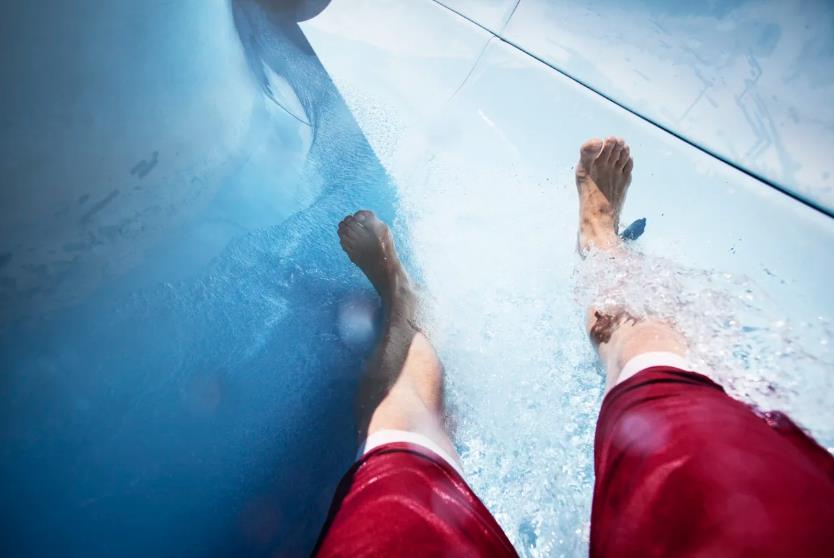Introduction: Water parks are a source of joy and excitement for many, offering a refreshing escape on hot days. However, the thrill of speeding down waterslides or floating along lazy rivers can sometimes overshadow the importance of safety. Among the many safety guidelines, crossing your legs on waterslides is one that might seem trivial but is actually crucial for both safety and comfort. In this article, we’ll explore why this simple action is important, along with other essential water park safety tips to ensure a fun and injury-free experience.
The Importance of Crossing Your Legs on Waterslides: One of the first things you’ll hear from lifeguards or see on safety signs at water parks is the instruction to cross your legs when riding waterslides. This isn’t just a random rule; it’s grounded in safety and physics. Crossing your legs helps maintain a streamlined body position, reducing friction and allowing you to glide smoothly down the slide. More importantly, it prevents potential injuries. When your legs are crossed, you reduce the risk of awkward positions that could lead to strains, sprains, or worse. It also helps prevent water from forcefully entering sensitive areas of the body, which can cause discomfort or injury, especially on high-speed slides.
The Role of Proper Body Positioning: Aside from crossing your legs, maintaining the correct body position is critical on waterslides. You should lie flat on your back, with your arms crossed over your chest or placed along your sides, depending on the slide’s design. This position not only minimizes the risk of injury but also helps you maintain control and balance as you slide down. Avoid sitting up or attempting to stand while on the slide, as this can lead to tumbles, collisions, and serious injuries.
Understanding Slide Dynamics: Waterslides are engineered for both safety and excitement, but understanding how they work can enhance your experience and safety. The speed and motion on a waterslide are the result of a combination of gravity, water flow, and your body’s interaction with the slide surface. When you follow the recommended safety guidelines, including body positioning and leg crossing, you allow the slide to function as intended. Deviating from these guidelines can disrupt the slide’s dynamics, leading to unintended consequences such as excessive speed, loss of control, or even ejection from the slide path.
Hydration and Sun Protection: Water parks are often synonymous with sunny weather, which makes hydration and sun protection vital aspects of safety. The excitement of water activities can make you forget to drink water, leading to dehydration, especially on hot days. Always carry a water bottle and take regular breaks to stay hydrated. Additionally, apply a broad-spectrum sunscreen with a high SPF, and reapply it every couple of hours, especially after being in the water. Wearing a hat and UV-protective clothing can also help shield you from the sun’s harmful rays.
Supervising Children and Choosing Age-Appropriate Attractions: For families with children, supervising your little ones is paramount. Ensure that the attractions they use are suitable for their age, height, and swimming ability. Many water parks have height restrictions on certain rides for safety reasons, so adhere to these guidelines to prevent accidents. Even in shallow water, young children should never be left unattended. Water parks can be overwhelming for kids, and it’s easy for them to get lost or venture into deeper water than they’re comfortable with. Designate a meeting spot in case someone gets separated from the group, and always keep an eye on your children, even in seemingly safe areas like wave pools or lazy rivers.
Respecting Water Park Rules and Lifeguard Instructions: Water parks establish rules to keep guests safe, and it’s important to respect these guidelines. Whether it’s waiting for the lifeguard’s signal before entering a slide or following the park’s dress code, these rules are designed to ensure everyone has a safe and enjoyable experience. Lifeguards are trained professionals whose primary job is to ensure your safety. Always follow their instructions, as they are aware of potential hazards and are there to prevent accidents.
Avoiding Rough Play and Dangerous Behavior: While it might be tempting to engage in horseplay or take risks on attractions, such behaviors can quickly lead to accidents. Running on wet surfaces, pushing others into the water, or attempting stunts on rides are all dangerous actions that can cause serious injuries to yourself and others. Remember that water parks are shared spaces, and your actions can impact the safety of those around you.
Recognizing Signs of Fatigue: A day at a water park can be physically demanding, and it’s important to recognize when you’re feeling tired. Fatigue can lead to slower reaction times, poor decision-making, and an increased risk of accidents. If you start feeling tired, take a break, find a shaded area to rest, and have a snack to recharge. Pushing through fatigue can put you and others at risk.
Conclusion: Enjoying a day at the water park can be one of the highlights of summer, but it’s essential to prioritize safety to make the most of the experience. From crossing your legs on waterslides to staying hydrated and following park rules, these tips are designed to protect you and enhance your enjoyment. By being mindful of your actions and aware of potential risks, you can ensure that your water park adventure is fun, safe, and memorable.
